I recently spent some time carrying a bigger revolver than I normally carry, and the experience reminded me how small details can make a big difference—often out of proportion to their size.
Instead of my normal J-Frame snub, I was carrying what I call a “compact service revolver,” and it didn’t take long to notice the benefits this type of gun had to offer. Since I haven’t written a lot about guns in this size and weight class, I thought it might be worth a detour to talk a little about the advantages of these fine revolvers.
Love the snub
First, by way of background, I should probably define some terms.
Those of you who have been around RevolverGuy for a while, will remember reading my thoughts on defining what a snub is. While I freely admit that the term “snub” is open to wide interpretation, and your definition may be very different than mine, it’s my personal view that the defining characteristic of the snub, which sets it apart from all its brethren, is its emphasis on concealment, first, over things like power, handling qualities, and performance.
Because concealment is the priority, I think a snub has to be small, to fit in tight spaces. This means a small frame, abbreviated grips, and a sub-three-inch barrel, to work in pockets, ankle holsters, and other out-of-the-way spots. You might define a snub differently, and that’s OK, but that’s where I draw the lines and it’s my point of reference for the discussion that follows.
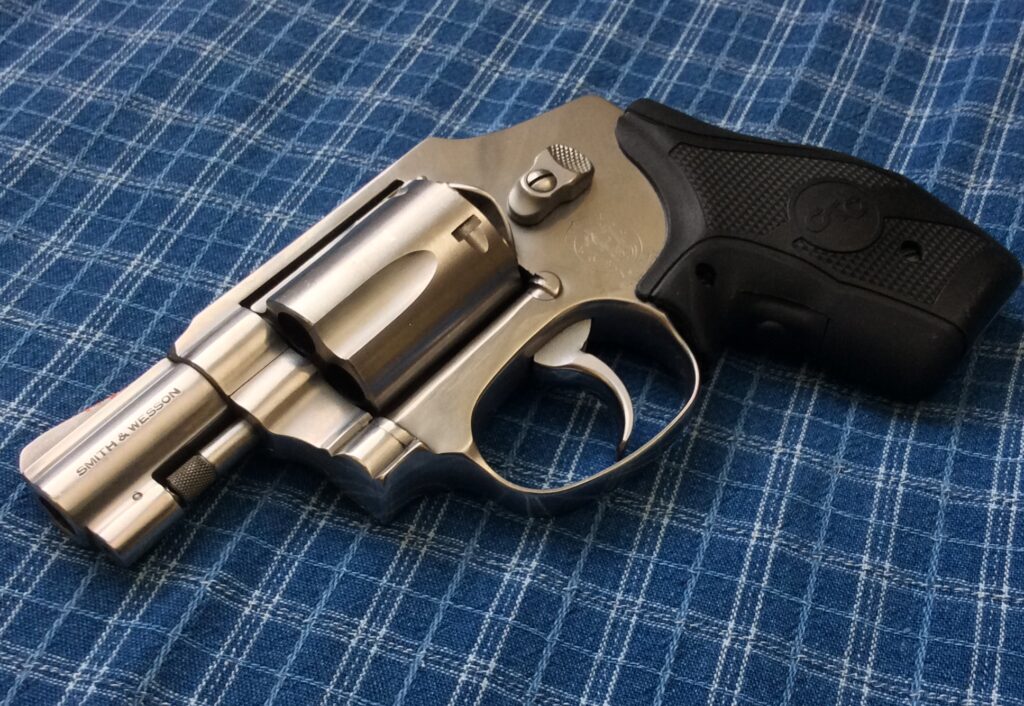
Now, the snub has a lot of things going for it, and does some things better than any other gun, but I have always considered it a compromise. If you could carry a larger, more capable gun, then you would, right? Perhaps you’d carry something that’s easier to draw, easier to shoot with precision, packs more punch, or holds more rounds, but the guns that can do those things have their own set of drawbacks, don’t they? They may be too big, too heavy, too uncomfortable, or too difficult to carry and hide in some circumstances.
So, we choose the snub. Not because it’s the best gun, but because it’s the best gun for the job, when concealment is the prime consideration.
Next, please
One step up from the snub, in my model, is the compact service revolver, which is a reduced size, reduced weight version of . . . you guessed it, the service revolver!
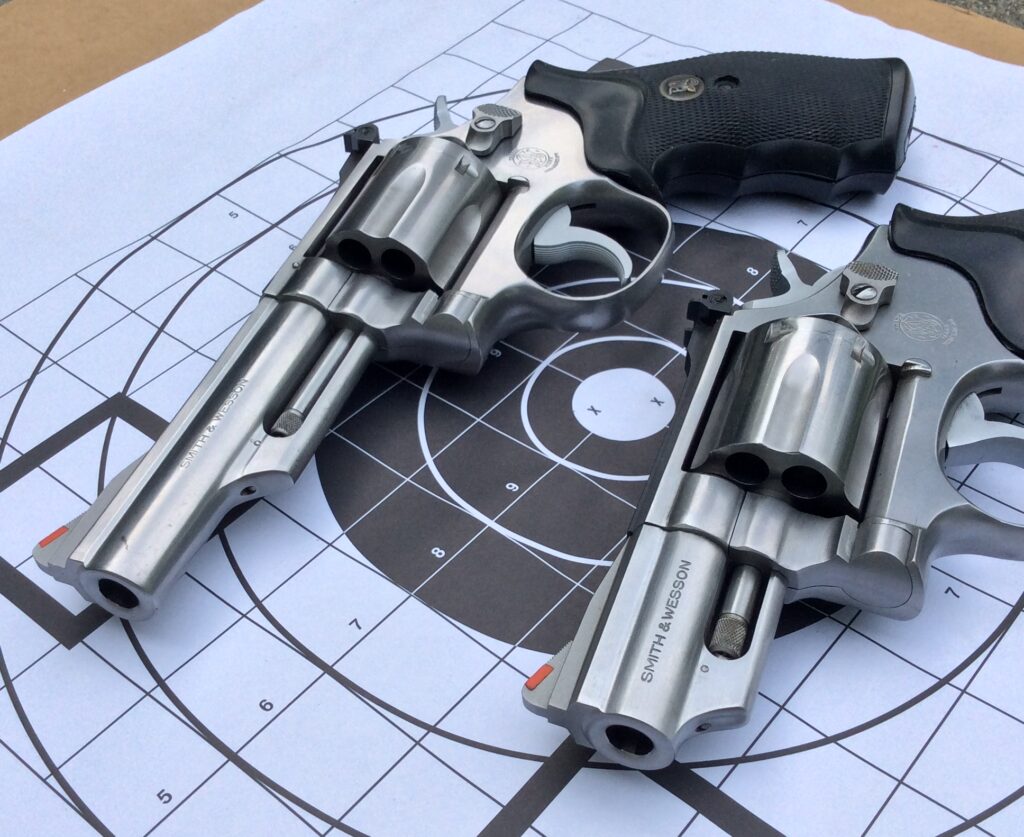
What sets the compact service revolver apart from the snub, in my opinion, is that concealability takes a back seat to the other factors. Concealability is still a priority, which is why we go to the effort of making the service gun smaller and lighter, but the compact service revolver places things like power, capacity, handling qualities, and “shootability” ahead of concealability. This makes it different than the snub, where concealability is always the first consideration, and we’re willing to sacrifice some of those other qualities to achieve it.
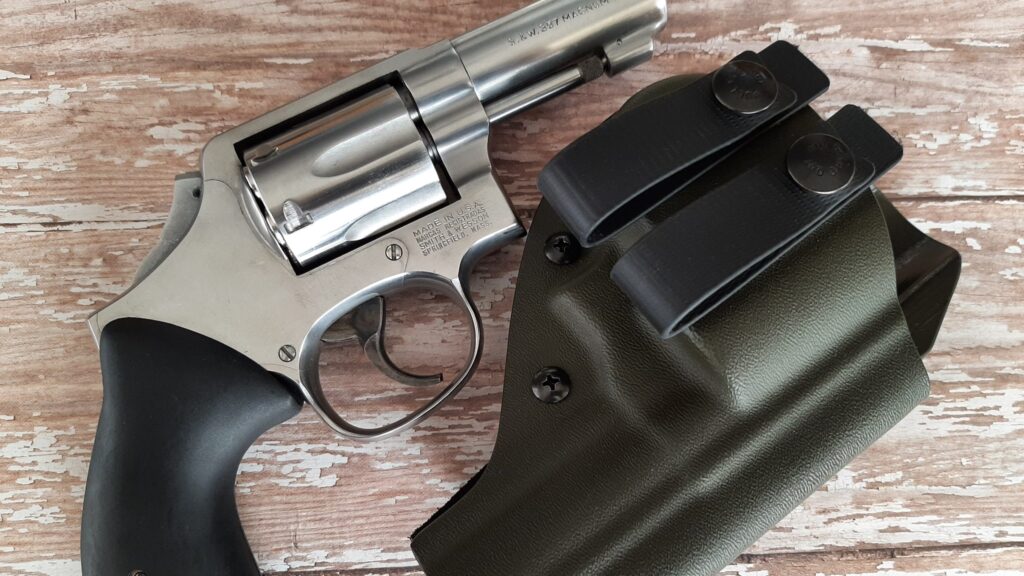
To further illustrate the difference in my mind, it’s helpful to consider how I’d carry these guns. As true concealment or backup guns, my snubs usually ride in pocket and ankle holsters, but rarely on my belt. You could certainly carry a snub routinely on the belt (and I understand why many RevolverGuys do, because it’s a convenient and capable option), but if my circumstances allow me to carry on the belt, then I can usually get away with carrying a bigger gun, and don’t need to shrink it down to snub size.
That’s where a gun like the compact service revolver shines. It will give you more capability than the smaller snub in those circumstances where your situation, environment, clothing and concealment needs permit you to carry the bigger gun.
Different missions, different guns, different modes of carry.
The standard bearer
In my mind, the classic example of the compact service revolver is the short-barreled, Smith & Wesson K-Frame, in all its blued, stainless, fixed sight, and adjustable sight versions.
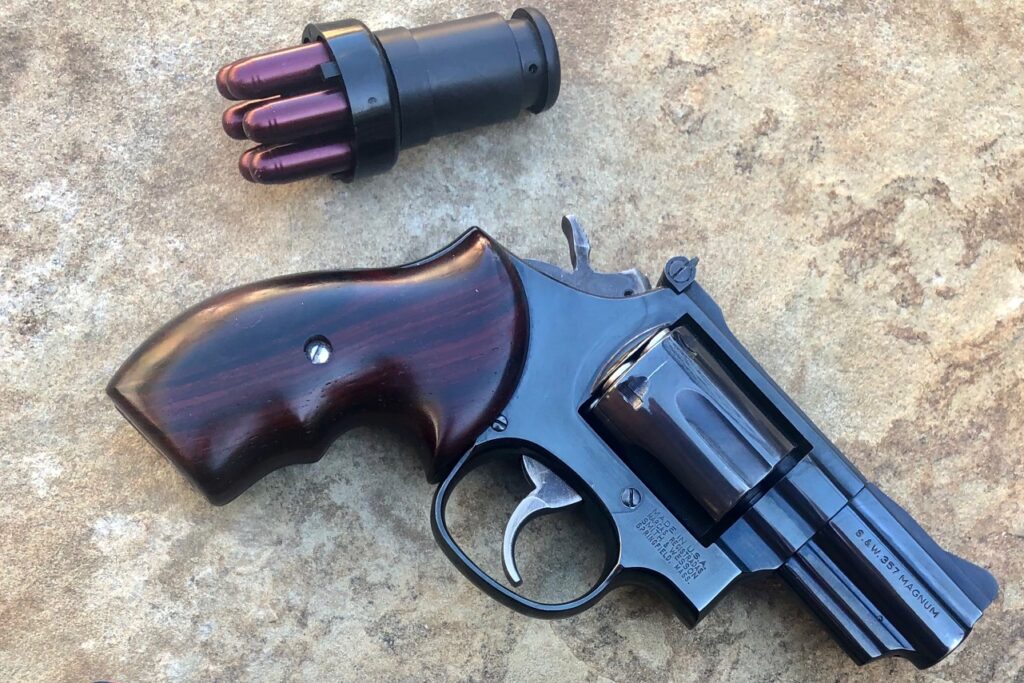
A K-Frame with a two-to-three-inch barrel, round butt, and compact grips defines the role for me, by combining service gun power and performance with enhanced concealment. You get the good sights, the six-shot cylinder, the hand-filling grip, and all the other service gun goodness, but it’s easier to hide than its big, service gun brother.
Not just Smiths
Of course, the compact K-Frames aren’t the only contenders in the compact service revolver category.
Perhaps the toughest alternatives on the market today are the shortened versions of the Ruger GP100. While they’re built on a heavier frame than the compact K-Frames, the 2.5-inch and 3.0-inch GP100s strike a pretty good balance between service gun capability and concealment.
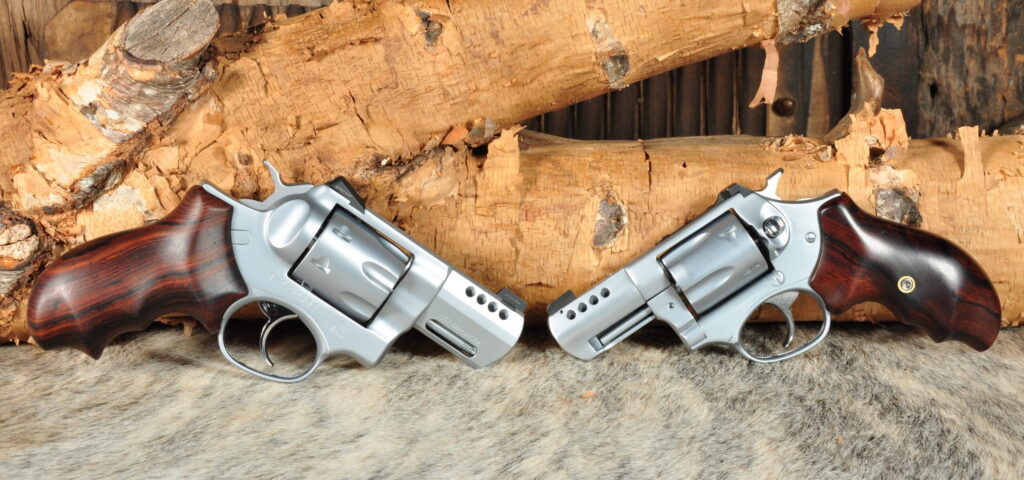
They’re still a little beefy in factory trim though, and make me long for the more-slender Speed Six of days past. I sure wish Ruger would bring that excellent gun back, as well as its square-butt, Service Six and Security Six brothers.1 If not that, then maybe a redesigned (again) six-shot SP101? Hope springs eternal . . .
Bucking tradition
The traditional way to build a compact service revolver is to start with a full-size, medium or medium-large frame service revolver, then trim it down, but these days, it’s increasingly common to take the opposite path, by making a smaller gun slightly bigger.
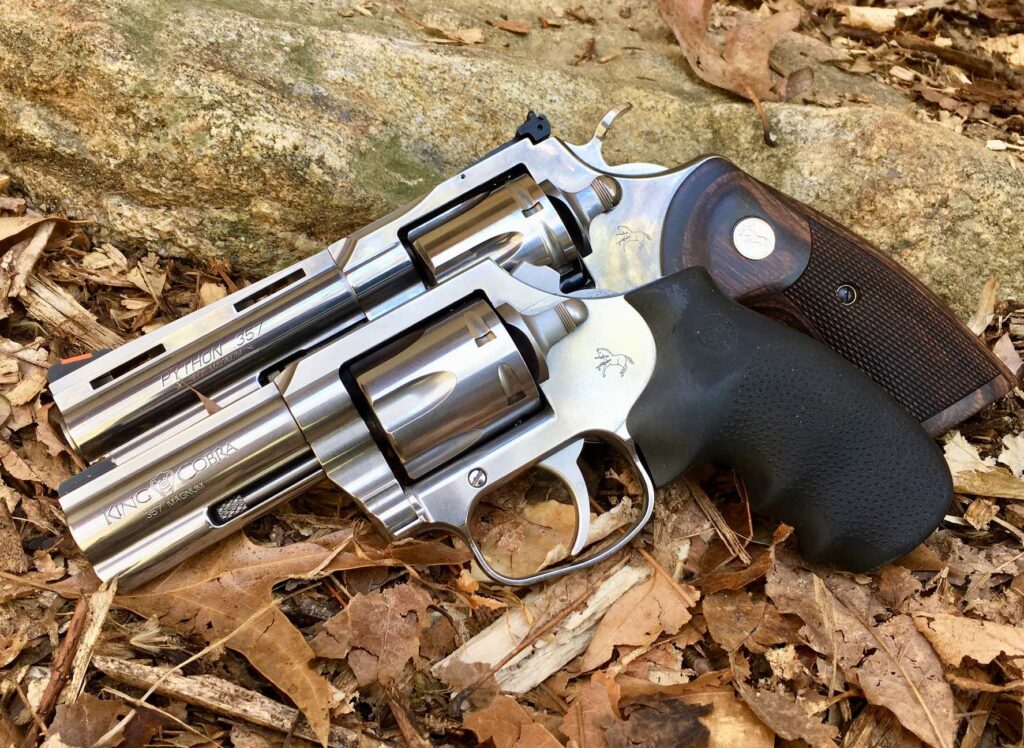
That’s the path that Colt has taken with their (new-2019) King Cobra, an excellent example of the compact service revolver in its modern form. The (new) King Cobra has its roots in the small-frame, (new-2017) Cobra action, but differs from that snub in important ways. The (new) King Cobra has a heavier, reinforced frame, a three-inch, full-underlug barrel, and is chambered in .357 Magnum—qualities which push it into the compact service revolver category, in my mind, despite the fact that it’s not derived from a larger, medium frame, service gun.
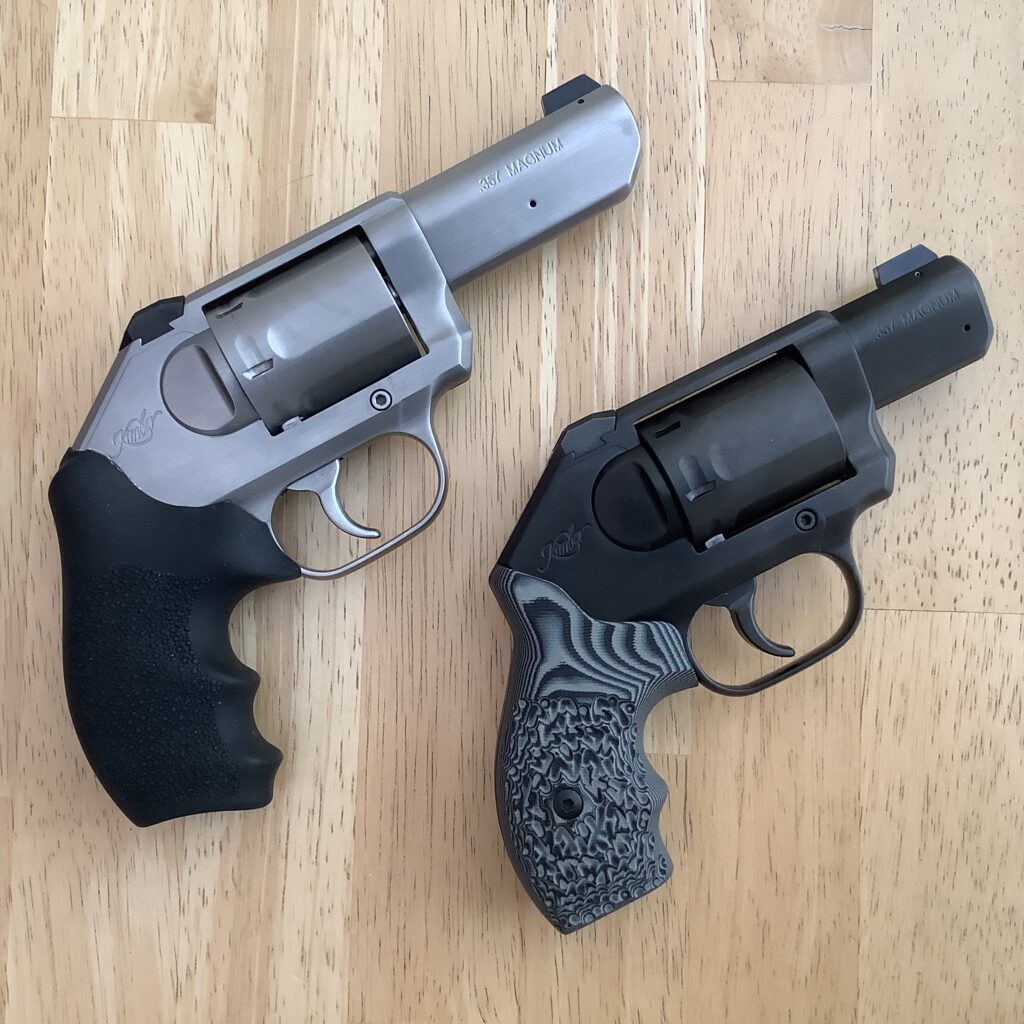
A similar gun is the three-inch, Kimber K6s Stainless that I’ve been writing about in these pages, recently. While it’s not a bobbed, medium-frame gun, the Kimber’s six-round, .357 Magnum cylinder, three-inch barrel, full size grip, and high-profile sights make this gun shoot like one. The three-inch barrel and large grips are what really push this gun into the compact service revolver category, according to my yardstick. The shorter, two-inch, boot-gripped version of the K6s qualifies as a snub in my book, but putting a three-inch barrel and bigger handles on the same gun moves it up a class, in my admittedly subjective view.
Advantages
So, with all the definitions and boundaries established, what are the factors that make carrying and shooting the compact service gun so different than the same experience with a snubby?
For me, they include the following:
-
- Full size grip.
The full-size grip is the key to the whole thing, in my book. Since concealment is the primary factor for a snub revolver, all of mine wear abbreviated, boot-style (h/t John Hurst and Craig Spegel) grips that are flush with the bottom of the frame, to keep things trim. You could certainly put a larger, extended grip on a snub if you wanted to, but it would increase the overall size of the package, and make it harder to conceal, carry and access in a pocket or ankle holster.2 As such, all of mine wear the shortened stocks, in sync with my philosophy of use. The way I see it, if I’m going to go to the effort of concealing a large grip (and we all know the grip is the hardest part of the gun to hide), then I want it attached to a large gun, so I can benefit from the advantages it offers over the snub.
Besides the size of the grip, there’s an issue of frame dimensions to consider. You can put an oversized grip on a small frame gun like a J-Frame, but it won’t change certain critical dimensions, like the room between the front strap and the rear of the trigger guard, or (often) the trigger reach. A medium or medium-large frame can relieve crowding, allow your finger to comfortably land in the right place on the trigger face, and do a better job of accommodating a larger hand than a small-frame gun with a big grip attached.
I think the bigger frame and grips on a compact service revolver really improve the handling qualities of the gun, compared to a small frame snub with boot grips. It’s easier to get a good grip on the gun, which makes the presentation from the holster more consistent, more secure, and faster. The full-handled (or nearly-full-handled) gun is also easier to shoot with speed and accuracy, by virtue of the added control afforded by the hand-filling grips.
Going back to the difference in frame dimensions, one of the things I enjoy most about the larger frame of the compact service revolver is the fact that there’s more room between the top edge of the belt and the leading edge of the grip, when the gun is carried in an inside-the-waistband holster. This really makes it easier to get a good grip on the gun, and perform an efficient draw. Sometimes, the middle, ring, and pinky fingers on the gun hand can get a little squished in this area, when you’re working with a small-frame revolver (or most autos, incidentally, because their general profile tends to place the front strap closer to the top edge of the belt), and you have to dig or lift the gun out of the holster a bit, before you can get a solid, firing grip on it. This slows the presentation and makes the grip less consistent.
I think the larger frame and grips are the most important features of compact service revolvers. The full-size grip is the biggest reason why it’s easier to get good hits with a compact service revolver, compared to a snub, and it’s the biggest advantage of this class of gun, as far as I’m concerned;
-
- Improved sights.
Because they’re usually derived from service guns, the sights on the compact service revolver are usually a cut above the average set of snubby sights.
Most traditional snubby sights are fixed and small, and offer a pretty miserable sight picture that may or may not coincide with the point of impact of your chosen ammunition.
In contrast, many compact service revolvers share the same high-profile, adjustable sights worn by their service revolver brethren. These larger, easier-to-locate sights often incorporate contrasting colors or outlines to aid in acquiring a good sight picture, and their adjustable regulation is a tremendous aid to accurate shooting.
Even the fixed sights on compact service revolvers are an improvement over those typically found on snubs, with larger blades and notches that enhance the shooter’s ability to put rounds on target quickly. The longer barrels on some compact service revolvers also help to reduce issues with sight regulation, by providing a point of impact that more closely matches the performance from a service-length barrel.
Manufacturers like Kimber have put more thought and effort into snub sights in recent years, while others, like Smith & Wesson, have offered select models with improved sights. As a class, however, they generally lag behind their compact service gun competitors, which is a significant advantage for the bigger guns.
-
- Improved capacity.
As a J-Frame guy, my snubs have always been five-shot guns in .38 Special. Until the new Colt and Kimber products came along, there really weren’t many realistic, six-shot options available in the caliber. You could try to find an older Colt Agent, Cobra or Detective Special, but they were less common, more costly, and more difficult to keep running, because there’s a shortage of parts and skilled gunsmiths to work on them.
As a result, the easiest way to get a .38 Special with more capacity was to move up to a compact service revolver. The compact K-Frames all offered six rounds, and if you were willing to step up to the larger L-Frame (or Ruger GP100 equivalent), you could get seven rounds. If you were a big enough guy that you could hide one, you could even go for the large N-Frame (or Ruger Redhawk) guns, which would give you eight shots of .357 Magnum on tap.
Although the math tells us that a six-round cylinder only offers a 20% increase in capacity over a five-round cylinder, there’s just something about that extra round that delivers confidence, way out of proportion to the numbers. From a statistical standpoint, it shouldn’t make much difference, but I think it feels a LOT different to carry a six-round gun, versus a five-round gun. Somehow, six feels whole, and five feels a bit incomplete. It feels like I’m giving something up, or making a compromise, with the five-round gun, but the six-round gun doesn’t give me that feeling—perhaps because six rounds was the service gun standard for most of the 20th Century.
There’s also the fact that the larger, six-round cylinders (and the speedloaders made for them) are a bit easier to manipulate during reloading. The cylinders on these larger guns have more clearance from the side of the frame, which makes it easier to charge them than the tiny snubs, with their frame-hugging cylinders (especially with a loader like the HKS, with its full-profile body). While this doesn’t change the on-board capacity of the gun, it does make it easier to get it back to full capacity in a hurry, which is the next best thing.
Again, the difference between five and six rounds shouldn’t be as significant as it seems to be, but I’ve come to accept it, even if I can’t explain it. As such, the increased capacity of the compact service revolver is one of its most important advantages, in my view.
-
- Enhanced power.
That’s especially true when the cartridges in the compact service revolver are more potent than the cartridges in the snub.
My favorite J-Frame is a Model 640 Centennial chambered in .38 Special, and I’ve always been happy with the balance of power and control that the cartridge affords in guns of this size.
In 1995, Smith & Wesson changed the Model 640 frame to accommodate a longer .357 Magnum cylinder (1.59” in length, compared to 1.53” in the Special), and added a longer, heavier profile, 2.125” barrel to the gun. While the new “Magnum J” was warmly received by many consumers, I have always preferred the earlier .38 Special version, for its reduced size and its chambering.
I’ve found the .357 Magnum cartridge to be a little stout in the all-steel, Magnum J-Frames, even with reduced recoil loadings, like Speer’s excellent .357 Magnum Gold Dot Short Barrel load. I can shoot the all-steel, Magnum Js well enough in slow fire, but the recoil is more uncomfortable, particularly with abbreviated grips and full-power loads, and it’s more difficult to control the gun as the shooting pace accelerates.
Of course, in the Scandium alloy-framed guns, which entered the S&W catalog in the early 2000s, shooting the .357 Magnum is downright painful, and control really suffers, to the extent that most shooters will be unable to fire a well-aimed, follow-up shot in any reasonable amount of time.
So, for me, the snub has always been a .38 Special +P proposition, and I’ve reserved the .357 Magnum for larger, heavier guns, with larger grips.
This is where the compact service revolver comes into play. It’s much easier to shoot .357 Magnum in a compact service revolver, with its full-size (or nearly full-size) grip, heavier frame, and typically-longer barrel, than it is to shoot it in a small frame snub with boot-style grips. While medium-sized guns, like the shortened K-Frames, aren’t intended to digest a steady diet of Magnums (as we’ve previously discussed), they do a much better job of launching the occasional Magnum slug with acceptable levels of accuracy and control, compared to their snubby brethren.
A recent comparison is useful, here, to help illustrate the point. In October, while working with a brace of Kimber K6s revolvers, I had the opportunity to fire Fiocchi 158 grain, .357 Magnum JHP ammunition through a two-inch-barreled snub with boot-style grips, and a three-inch-barreled gun with larger Hogue Bantam grips. Shooting the two-inch gun with the full-power Magnum loads and short, open back, G10 grips wasn’t particularly pleasant, and I felt like the cartridge was a little too powerful for the combination.
In contrast, the softer Bantam grips on the three-inch gun filled my hand better and allowed a full, three-finger grip on the gun. This, combined with the additional weight and sight radius afforded by the longer barrel, made a dramatic difference in comfort, control, and accuracy (groups with the three-inch gun were an inch-plus smaller at 10 and 15 yards). The bigger gun, as outfitted with the Bantams, was incredibly effective at taming the recoil of the full-power .357 Magnum, to the point that it didn’t seem reckless to load with .357 Magnums for carry. In contrast, I felt the two-inch gun was better suited for .38 Special +P, to retain an acceptable balance between power and control.
I’m not going to engage my inner bullet nerd and dive into a detailed discussion about terminal ballistics at this point, but I will say that experience has shown there’s a notable difference between .38 Special +P and .357 Magnum performance that cannot be ignored. RevolverGuy readers know about my affinity for the .38 Special, and understand that I don’t suffer from “Magnumitis,” but there’s just something about the .357 Magnum that engenders confidence, isn’t there? I’ve never known anyone who carried a .357 Magnum who fretted about whether he was “carrying enough gun,” and I think it’s a definite advantage of the compact service revolver that it brings controllable Magnum Force to the table in a way that most true snubs can’t.
You don’t have to load Magnums to take advantage of the effect, either. The compact service revolver will do an equally good job of taming .38 Special +P loads, as well. Those 158 grain +P Saint Louis loads, that give your hand a good thump in the J-Frame, will be a lot easier to control in an abbreviated K-Frame.
Putting it together
For me, the sum of all these factors is increased confidence in the gun and my ability to get the job done with it.
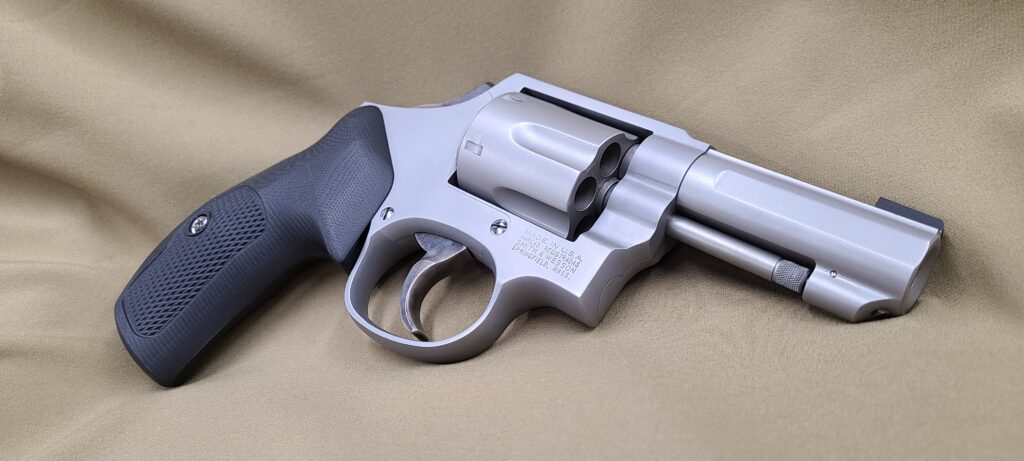
Please understand that I appreciate the extraordinary capabilities of the humble snubby, and think it’s the ideal combination of size, weight, power, controllability, and effectiveness when concealability is the primary consideration. The truth is, I carry a snub revolver more frequently, but the enhanced qualities of the compact service revolver really set this class of gun apart from the snub, and make it a better choice when concealability is an important factor, but not the most important factor.
For those jobs where shooting and handling qualities, power, capacity, and performance take precedence over concealment, the compact service revolver is the one to beat.
The wheel turns
These days, you’re more likely to see those kinds of jobs done by compact semiautomatic pistols, and if the Glock 17 is truly “the Model 10 of the 21st Century,” then the Glock 19 is the modern incarnation of the round butt, 2.5” Combat Magnum—a polymer-framed, semiautomatic version of the classic, compact service revolver.
A young or new shooter who was raised in The Polymer Age might (understandably) be uncomfortable at the prospect of carrying a gun with single-digit capacity, a relatively slow reloading capability, and a caliber that isn’t measured in millimeters, but I share no such reservations. While I’d feel very well armed with a Glock 19, and often carry one, I wouldn’t feel any less prepared for the scenarios I’m likely to face with a properly-stoked K-Frame on my belt.
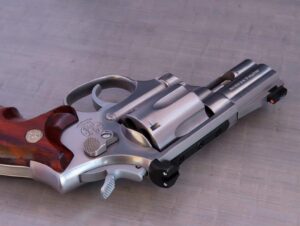
Perhaps that’s a function of the fact that I was raised in a time when the six-shot revolver was still the standard sidearm for law enforcement officers and armed citizens across America, and remained standard issue in my branch of military service for several years after I took the oath.
Economists will tell you that when you enter a market for the first time, the prices you discover become the baseline that you will use for all future comparisons—that is, everything will be measured against those figures, from that point forward (which is why I think a box of 148 grain wadcutters “should” cost me about $6 or $7, and a brick of .22s “should” cost me about $9 or $10!). Well, I think there’s something similar to that, working here. Six rounds of .38 Special or .357 Magnum in the gun was enough for many generations of American cops, servicemen, and armed citizens, and it was the service gun baseline in my formative years. I grew up shooting guns like this, and I don’t feel particularly naked with carrying a gun that “only” has six rounds in it.
priorities
More importantly though, I understand that while equipment is an important element of our defensive preparation, it’s not the most important element. As we’ve talked about before, your mindset, awareness, tactics and training are all much more important to your successful defense, than the gun you’re carrying. The revolver, in any of its various forms, will do the job if you are capable of doing the job.
Friend Evan Marshall once remarked about this, in his own inimitable style, when he said:
If they told me I had to go back out on patrol with a six-round revolver, backed up by a five-shot snub, my first question would be, “what’s for lunch?”
I think that captures it perfectly!
Proven winner
While there’s certainly an aspect of familiarity involved, that gives me as much confidence in the compact service revolver as one of the modern, plastic, wünderpistolen, I think there’s an even more important factor to consider–they just plain work!
It’s silly to think that something as serious as defensive firearm selection could be influenced by popularity or fashion, yet I’ve seen the cycle play out so many times that it just doesn’t surprise me, anymore. Firearms trends come and go, and what’s hot this week, is old news next week, when the latest hot rod blaster or darling caliber hits the newsstands (did I just betray my age? Should I have said, “mobile devices,” instead?). Sometimes, it can be a little dizzying, trying to keep up with it all.
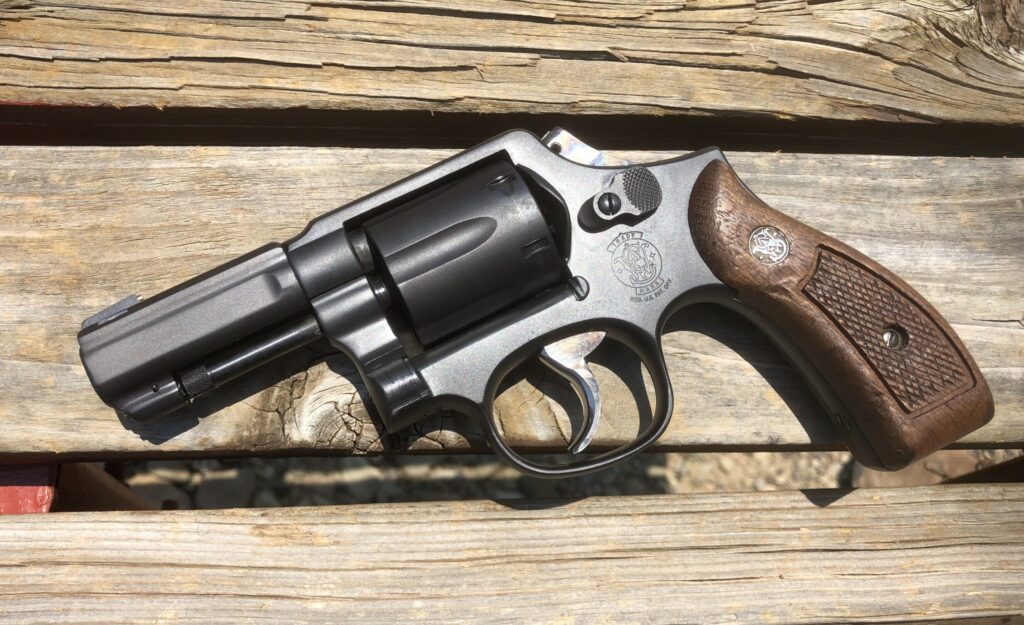
But, if you take away all the distractions and noise, you’ll understand the job of the carry gun is to put effective, first rounds on target, and despite having a little gray in its beard, the compact service revolver does that really well in trained hands. It’s quick out of the holster, points well, shoots straight, and hits hard . . . just like it did in your grandfather’s, or great-grandfather’s era, when the men and times were tough.
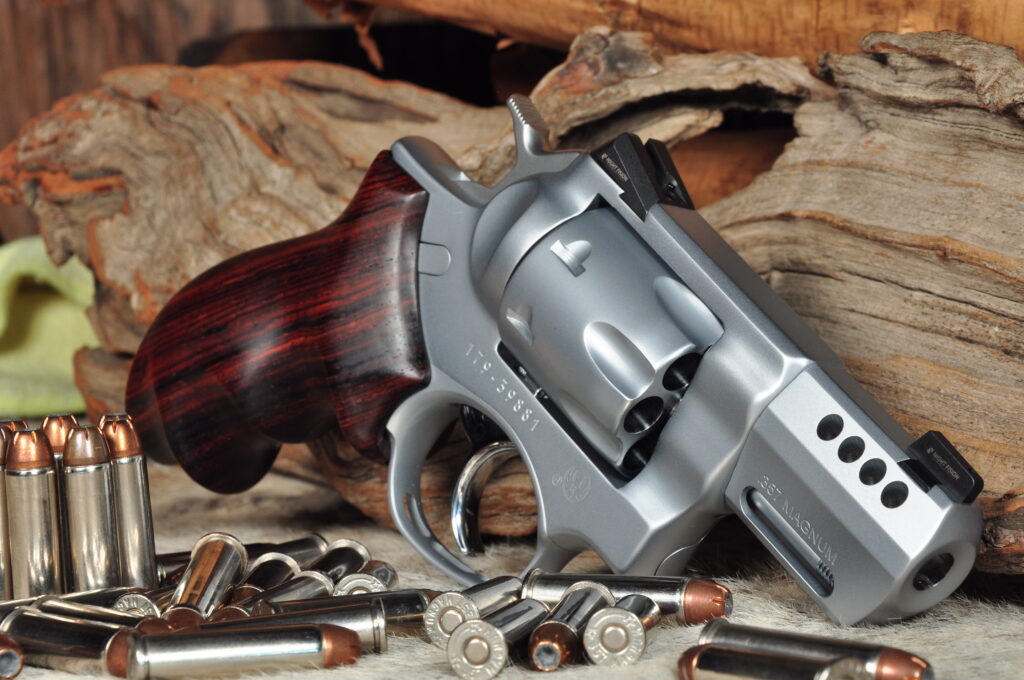
The wheel has turned a few times since they were young men, but the compact service revolver is still up for the job, if you are. This is why they continue to sell so well, and why custom makers like Marc Morganti, Dave Lauck, Nelson Ford, Milt Morrison, Karl Sokol, and Dave Laubert keep so busy, building them for serious men and women who clearly understand their needs, and know how to use their tools.
The compact service revolver isn’t going anywhere, anytime soon, and actually seems to be experiencing a bit of a resurgence, based on what I’m seeing in the market, and what’s being reported by the industry professionals (including trainers, holster makers, gunsmiths, and gun manufacturers) that I associate with.
That sure brings peace of mind, and a smile to the heart of this RevolverGuy!
****
Endnotes
-
For those late to the game, the excellent (and sorely missed) Speed Six was a medium-frame, six-shot, .357 Magnum (normally, although .38 Special and 9mm versions were chambered) revolver with fixed sights, a round butt, and an abbreviated, 2.75 inch barrel (in my favorite version, although a four-inch model was also catalogued). While Ruger has done their best to fill the void left by the discontinued Speed Six with similar models from the small frame SP101 and medium-large frame GP100 series, they just haven’t filled the Speed Six’s shoes, in my opinion. They’re fine guns, and I’m particularly fond of the abbreviated GP100s, but the SP’s reduced capacity and the GP’s extra size and weight handicap them in comparison to the older Speed Six, in my view;
-
That’s not to say that you can’t make bigger grips work in these roles. Friend Dean Caputo has told me several times that Pachmayr Compacs work pretty well on J-Frames in ankle holsters, based on his experience, and we all know the story of how John “Fitz” Fitzgerald carried his specially-modified, Colt New Service revolvers in his hip pockets. With a big enough pocket, or a wide-enough pant leg, you can make bigger grips work, but the smaller grips will always be easier to hide than the bigger ones. I can fit my boot-gripped Model 640 in the hip pocket of my jeans, for example, but there’s no way I could do it with a set of Compacs mounted. Similarly, I can make the same gun work in an ankle holster, wearing a pair of straight-legged jeans, but a longer grip would foul the draw.
-
Additional info from Marc Morganti on the custom GP100 featured above: This is a WCGP100 . . . (which) utilizes our 2.250” Ultimate barrel that we custom machine from Krieger large OD barrel stock, along with a set of our medium length Exotic Wood grips. We can custom make our grips even shorter if desired, but these two items certainly help to minimize the large capacity magnum revolver to near small frame dimensions. We can go even shorter on the barrel too, by nearly 0.500”, but this customer wanted 2.250”. This makes a fantastic medium frame, high capacity magnum revolver that carries like a small frame magnum. All WCGP100 Rugers are configured with the excellent Novak Lo Mount rear sight as well as Novak front sight, We upgrade these to a Novak three dot night sight configuration. That’s about as “Combat” magnum as you are ever going to find. Real sights on real revolvers with 7 rounds of .357 magnum. That’s a great combination.
About the Featured image:
This S&W Model 64-2 started life as a four-inch service gun, but talented Gunsmith Dave Laubert shortened its barrel to three-inches, added a 14K gold bead sight, polished the thumbpiece to remove sharp edges, and converted the action to DAO, creating a beautiful, compact service revolver. Dave is known for these excellent conversions, and RevolverGuy readers are encouraged to check out his fantastic work at http://www.defensivecreations.com/. Image courtesy of Dave Laubert and Defensive Creations.

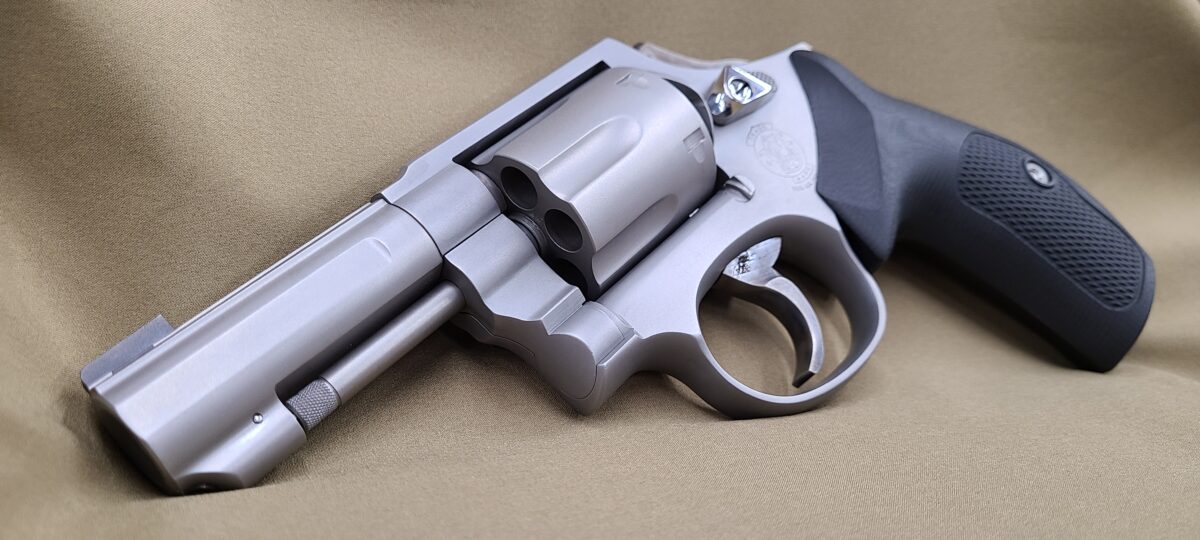
Market alert, 3 inch Ks just took another spike in price. 🙂
Excellent article Mike. Back in the old days I used to look forward to getting up early to coffee and the paper, now it is coffee and this website.
If I had not been already hooked on them your article would have caused me to swallow the hook.
I rely on 3 primary platforms, Js , 3″ Ks & BHPs depending upon destinations , some urban areas all 3.
Thank you for this article and for all, you do for the community of revolver dinosaurs.
Stay safe in this insane world we live in!
Tony
Tony, I’m always envious of the guys who can scoop up those trade-ins like we’ve been seeing from AIM Surplus, lately. Had I been living in Free America, I would have cleaned out their recent inventory on Day One! Lots of good 4” K-Frames, waiting to be turned into 3” customs from talented ‘smiths like the ones I mentioned.
Thank you so much for your kind words about the article and site. It’s always wonderful to hear from satisfied customers! What a great community of RevolverGuys we have here. I’m proud to be part of it.
BTW, just a warning: If someone wants to show you the new FN HP, avert your eyes! You won’t be able to scrub that horror from your mind, as a classic BHP fan.
A hearty “Amen!” to this one, Mike. Your coverage of the advantages of the CSR is spot on. An abbreviated K frame is really the smallest reasonable sized gun to use if you plan on achieving competency with the .357 Magnum. I completely agree with your 6-round assessment; 5 in the gun seems too few, 6 fixes that uneasy feeling. Shooting and running CSR’s is much easier than doing so with a snub. The triggers/actions on K frames are usually better (or can be made better) than those of J frames, too. That capability should be given priority if the environment allows hiding them- Carry the CSR unless it cannot be hidden and then default to the snub. Thanks for giving these fine guns some love and for recognizing guys that can customize them.
Thanks Kevin! Glad you liked it, and I appreciate your extra thoughts on it. I hadn’t considered the triggers, but you’re right—it’s a lot easier to get a good trigger on a K. That’s definitely another big selling point.
I don’t spend as much time with this class of guns as I would like. Most of my revolver time is spent with snubs, these days, but I was glad to focus on these great, middle-ground guns for a while.
A lot of food for thought in this article.
Personally, I almost always carry concealed a Smith J-frame, not because it’s the best handgun for that purpose, but because for me it covers most of my needs fairly well. In other circumstances I’d much rather carry a K-frame “wobbler”.
And hear, hear about Ruger bringing back the Security Six line, arguably their finest mid-sized double-action revolvers. Some of us even would pay extra for them if Ruger spent more time fine-tuning the actions and improving fit and finish.
Well, maybe that’s a pipe dream in our current throwaway, “tacticool” firearms culture.
Ruger’s “Tell The CEO” feedback program is currently turned off, for some reason, but I’d love it if all the RevolverGuys out there told Mr. Killoy we wanted the Six-series back!
Tell The CEO
Solid article, Mike and I fully agree. My 3″ King Cobra really hits the sweet spot for an all-arounder. Easy enough to conceal in an IWB holster for all day concealed carry, yet sizeable enough that it’s often my choice for heading out the door on a hike (when I’m not grabbing my GP-100 7-shot).
A new Security Six offering would be the bee’s knees. Or, at the very least, Ruger really needs to bump the SP-101 up to 6-rounds of .38/357 to compete with the Cobra and K6S. I’m guessing they’ve heard that feedback more than a few times recently…
Thanks Hammer. I’m super glad to hear you’re getting such good mileage out of the new King. I’m still a little torqued that they recycled the name, but think they did a good job on that middleweight!
I have had to wait for my blood pressure to settle back down – be still my fluttering gun lust. I think Mike missed his calling as a creative author! This column reminds me of an old saying, “A Smith & Wesson beats Four Aces.”
I had an academy instructor who related a tale to us. I can not vouch for its veracity, or anything else. It was about a Chicago cop who confronted a perp wielding a .45 auto. The cop drilled the perp with a one shot stop, dropping him dead with a 158 grain round nose lead slug. When asked whether he questioned the adequacy of the old .38 Special RNL, his reponse was alleged to have been, “My man, one shot straight with my .38 beats him giving me jive with a .45.” Thus launched by eternal love for the .38 Special.
The compact service guns have been my best companions in street clothes through the decades. A lot of .357 loads, and even more .38 Special loads were put through them, and never was there any issue in practice, in training, or on the street.
The trend to bottom feeders was bolstered by the notion that the autoloader was lighter, held more rounds, faster to shoot and reload. Yeah, but I saw too many funtional mishaps over the years in training, not just with Glocks, but SIGs and Berettas.
There’s something comforting about having Six For Sure. (or Five even)
It plain works. You’ve seen it and lived it, Stuart. Of course, it’s more about what’s between the ears than what’s in your holster. I have a feeling you would have been just fine with an old tip-up .32, because your head was in the right place.
A .357 K is definitely more comforting, though!
If I was smart, I’d start investing in these things before I published articles about them. Gobble up all the surplus K-Frames before I stoke the coals and get the wallets opening up! 😆
I agree with most of the comments here. I think both S&W and Ruger made unforced errors when they discontinued, respectively, the .357 K-frames and the Security/Speed-Six series. Their “replacements,” the L-frames and the GP101, are fine guns, but they’re too heavy to carry all day and too bulky to conceal consistently. Smith kinda redeemed themselves by reintroducing the 19 and the 66 (although I constantly hear of QC problems with them), but Ruger, not so much. You can only do so much to make a GP100 concealable; even with a short grip frame and a short barrel, you still have that fat cylinder to deal with. And with both companies making (half-)polymer revolvers, and Smith making Scandium J-frames and N-frames, the weight problem is certainly solvable, and revolver-philes wouldn’t have to get so teary-eyed over the Model 12. (The King Cobra looks like it could be ideal but I’ve never seen one, so I have no opinion on it. )
Now that I’ve cleaned the drool out of my beard thanks for the photos! My only K frame is a four inch, I just can’t bring myself to shorten it. My other two carries have three inch tubes: Kimber and a Ruger LCRx in .38… By your metric that Ruger almost makes CSR with the original Jordan style grip but for the five chambers. On which note, yes, that extra round matters, out of proportion to the percentage. I think about it as five shots are plenty against one assailant, possibly enough for two, but three? More? I’ve responded to two separate incidents in which a single person was victim to a robbery attempt by SIX(!) goblins. it’s rare, but seems to be getting more common. Yes, yes, shoot the leader and the pack will scatter… until they don’t.
Riley, that’s an excellent observation. Criminals have always worked in concert, but it does seem that the groups are getting bigger in size. That sixth round could definitely make a difference in the worst case, and turn a one bad guy gun into a two bad guy gun, with some judicious ammunition management.
“Goblins.” Bless you for that. El Jefe is smiling!
I wouldn’t hack on your 4” K-Frame. I love that combination, and if I only had one K, I’d definitely want it to have the service-length, 4” tube. To be real honest, the 4” barrel is no hindrance, and might actually carry better than a 3”, particularly OWB.
I too have a .38 LCRx and carry it frequently. It’s a great shooter, but the limited ammo concerns are why I also carry a speed loader for an extra 5 shots. I don’t see a situation in which 13 shots will resolve what 12 won’t, but I do see a situation where 10 will resolve what 5 won’t.
Agreed, Sir, I carry several reloads. I’d rather not have to reload in the middle of a fistfight tho..
I have a 66-3 with 3″ barrel and carry it OWB in a Bianchi pancake holster. It carries just fine. My 66-2 4″ actual rides a little better as that one inch forces the butt closer to my body using the same holster. Keep the 4″. Go get a King Cobra 3″
Going back and rereading the article more carefully, including your end notes, I see that most of my comments merely echo the ones you made. Am I embarrassed to find that I just parroted back most of your article? Heck no; it just proves the depth of my knowledge and the sagacity of my thinking. (Or maybe it proves yours. I’ll leave that to the philosophers.)
One question, though: Since you rate the two-inch Kimber K6S as a snub, and the three-incher as a CSR, would you do the same to the old Colt D-frames? In other words, would you consider a 2.5-inch Diamondback, which is basically just a tarted-up Detective Special with adjustable sights and a square butt, a CSR version of the Detective Special? (Personally, I would, and did; I considered the Diamondback I carried for a while to be a belt gun and the Dick Special to be an ankle gun, but they’re really both the same gun. That makes two things I have to leave to the philosophers in one comment.)
Haha! 1811, I doubt my wife would label me “sagacious,” so I’m more than happy to accept the compliment from you!
Dancing in the gray areas can get tricky, but yes, I’ve always thought of the Diamondback as a CSR while the Detective Special was a snub. If I had a Diamondback (I might as well dream of batting 400, or hitting the lottery, but what the heck, why not?) I would definitely carry that target-sighted, square-bottomed beauty on the belt. If I’m not mistaken, the Diamondback had more of a target hammer, too, which is one of those small changes that leads to big consequences—-I wouldn’t relish trying to dig it out of a pocket.
I thought you were correct about the hammer, and I went to imfdb.org (the Internet Movie Firearms Database) for confirmation, since I knew that Steve McQueen carried a Diamondback in “Bullitt.” And, yep, it has a wider, oval-shaped hammer spur that would pretty much preclude pocket draw.
(Imfdb.org is a great resource and a fun read, and “Bullitt” is the best movie that was ever put on celluloid. If you’ve never seen it, why am I still talking to you?) (In fact, I mentioned on another blog just last week that if you watch “Bullitt,” you can see the SFPD coppers they used as extras with their issue .41 Magnum Model 58s in their holsters.)
Rest easy, friend. I’ve watched it a number of times, and not just for the chase scenes.
Another blog? Should I be jealous? 😁
Mike,
Once again primo stuff! Great article.! I have been a police officer 32 years now and I agree with Evan Marshall. If I was told I had to go back on patrol with a 6- shot revolver backed up by a 5-shot revolver, my first question would be, where’s breakfast (I am a midnight shift guy to my core). Some of the most interesting (read dangerous) stuff I ever did was with my six shot, 4” model 19 on my belt.
Keep up the good work Mike.
BC
Thanks BC! Great to hear from you! Much appreciated. Stay safe out there!
A 3″ HB S&W Model 65 .357 for the Wife, and a 2.5″ Charter Bulldog .44 for me. Almost everyone I know turn the noses up at the thought of relying on a Charter Arms revolver, and they have had quality control issues, but I have had mine for 15 years with a couple of thousand rounds through it. I would, and do trust my life with it.
I really like your articles Mike…..I get all happy every time you drop a new one…..
Thank you Sir! Glad you’re enjoying the site. Nothing to complain about, with those choices. Charter has had ups and downs, but if you’ve got a good one, you’re well-armed, indeed. Heck, every maker has had ups and downs . . .
I have looked for a 3” Model 65 Smith for years and found one at a show this weekend. Not for sale. He was displaying his trigger job acumen. Nice trigger but still not for sale. They were FBI issue for a while and I worked with one quite a bit in the 90’s as a test piece. They are a handful with 125 gr Mag HP loads but I think it would be perfect with Buffalo Bore .38 +P 158 LSWCHP’s. Put on some of those boot grip like grips that Brownells sells and paint the front sight. Done.
Argh! So close, Brett! Don’t worry, I’m sure there’s one out there, waiting for you to find it.
Another great article Mike. I often carry a GP100 3” and never feel undergunned.
When I bought the GP as a retirement gift to myself it was a nod to the Service Six I started on the job with in ‘89. I too would be happy to go back on patrol with a wheel gun.
Those photos are like artwork to me, just beautiful pieces. Don’t think I’ll ever say that about a semi-auto.
Finally I agree on the 5 vs 6, big difference. I briefly considered the SP101 but it just felt like a back up gun to me.
Great stuff.
Thanks Matt, glad you enjoyed it! Yes, those guns are truly functional art!
I’m glad I’m not alone with the six versus five reasoning. It’s hard to explain objectively, but it just feels right. Six seems whole, five seems like a compromise.
I just read where a Kimber K6 with a 4 barrel averaged 2.83″ groups at just 15 yards from a bench rest with .357 loads. That, along with the revolver’s other issues, doesn’t inspire confidence.
That’s certainly nothing to brag about.
I’ve had better luck than that with my two and three-inch guns, but have a friend whose two inch gun is tumbling bullets at 15 yds—they’re literally striking broadside!
Methinks QC has been irregular.
Of course, the trigger actuator in that group you reported could be the problem, too. You can shoot some terrible groups off the bench if you’re not doing things right. The bench is no guarantee of accuracy.
“Methinks QC has been irregular.”
Sounds like a Kimber!
“Of course, the trigger actuator in that group you reported could be the problem, too”
Well, it was in a NRA magazine, so I assume they employ people who know what they’re doing? *shrugs* Still, a 4″ barrel k6 lobbing darn near 3″ groups at 15 yards is really bad. Yikes!
Yes, that’s not very impressive, is it?
Excellent article, thank you for publishing.
I have a 2″ Model 64, a 2 1/2″ 66 and a 4″ 65 (being cut to 3″) down at Tiger McKee’s Shoot Rite Firearms right now getting action jobs and new sights (XS Big Dot fronts), I cannot wait to get them back, for all the reasons your write about. The 64 and 65 are recent acquisitions but the 66 was my first new gun I purchased back in 1981. It will feel good to carry her regularly again.
Please report back on them when you receive them, David. It looks like Tiger is doing great work.
Great article! I enjoyed it very much, and I agree with all of your points.
My budget doesn’t currently allow me to have a quality Smith, Ruger, or Colt, but I do own a Taurus model 692 .357 magnum that I believe meets your criteria to be classified as a compact service revolver. It has a 3 inch ported barrel, 7 round capacity, target sights, weighs 35 ounces, and is about the same size dimensionally as a Smith 686+ of the same barrel length (I think. At least as near as I can tell).
I have bobbed the hammer and installed CT laser grips. It’s been reliable and given me no issues. I have found a way to carry it concealed and fairly comfortable, and it is real comforting to know I have such a good self defense package with me.
Thanks again for the great article!
Long life the compact service revolver!
Glad you enjoyed it Rick, and welcome aboard! It sounds like you’ve got a good setup with your Taurus. I’m a fan of the CT Grips. We did an article on them a while back that you might enjoy:
Link: CT Lasergrips For Revolvers
Thanks Mike. I will check it out.
Nice read, Mike. I enjoy all of the articles on R.G. Though I have a place in my heart for revolvers, I usually carry a poly or alloy frame hi-cap auto. At my advanced age, a few (or several) ounces make a difference. I love shooting revolvers and appreciate their simplicity, punch and accuracy.
Thanks Jack! If you don’t tell anyone, I’ll let you in on a secret . . . I do too.
Taurus has gotten the jump on S&W and Ruger with the release of the 856 Defender with its 6-round cylinder, 3-in barrel, full 3-finger grip and red-outlined night sight. I found the trigger action of mine smooth but too heavy, so I have had my gunsmith lighten the action. While I love my 4-in S&W Model 10-5 and 67-1, the steel Taurus 856 Defender is a whole lot easier to carry while retaining most of the benefits of the K-frames.
Great article and comments. Ruger wouldn’t bring back the original Six series because all the tooling and gages were sold in the late 1980s. A slimmed down and lightened GP100 size could be done using a polymer frame and fluted cylinder as in the LCR. I’m using a Colt Official Police bobbed to 3 inches by Sandy Garrett of NoVA Gun Works, which scratches the CSR itch for me.
Thanks Ed, much appreciated! I was hoping for an improved Six, with new tooling, but that’s probably like wishing for a vacation home on the Moon, at this point.
Well… I don’t speak for Ruger but they come out with new things all the time, if they believe they will sell. They created the tooling before and I think that if they believe it would be profitable it should be easier and less expensive now that all the engineering problems have been solved.
And I have been looking at some beat-up used Speed Six revolvers online, and at pictures of the stainless 3″ Speed Six they made for the US Postal Service in 1988, and doing some hard thinking. I think that it would be trivial–you wouldn’t even have to be an engineer–to modify the Speed Six frame in a manner to make it even more suitable for this kind of thing.
This is what I have in mind, specifically. Mill off the gripframe–or manufacture it that way already, with maybe a .25″ radius around the hammer axis pin hole. Make a skeletonized rectangular mainspring housing like the SP101 has, with the same external dimensions as that part of an SP101 but make it a separate part, out of lightweight aircraft aluminum, and attach it to the steel frame underneath where the hammer pivots using a couple of screws and some red Loctite. As the trigger guard is also a separate piece in these guns, make it out of lightweight aircraft aluminum alloy too. Make a 3″ .357 version and put the same grip on it that the SP101 has. Black paint on the rear facing vertical portion of the rear sight, and orange on the front. And that’s that. It will never be quite small enough to carry in a pocket, but with a good holster it should be pretty manageable.
I’ve also been thinking about appropriate ammunition, and thinking that the 110gr Hornady XTP loaded to do around 1300 from the 3″ barrel ought to be a decent performer without excessive recoil that could slow down followup shots. This should be easily achievable at pressures that won’t erode chamber throats or crack the forcing cone. Back in the 80s the Border Patrol carried .357 revolvers, some of them purchased from Ruger, and their duty ammo was a 110gr jacketed hollowpoint loaded to a nominal 1300 ft/sec, and I never heard anyone say anything bad about it. And back in those days, before they were kindergentlerized and forced to babysit the invaders instead of chasing them down and shipping them back, the Border Patrol used their guns. A lot. The load seems to have been a very good performer, and the Hornady bullet, with its jacket that goes all the way up to the edge of the hollowpoint cavity with no exposed soft lead except inside, would be very well suited to carrying in a speedloader or speed strip that gets dropped into a pocket.
158gr soft lead hollowpoints loaded to around 1100 look good on paper, and would likely perform well in a block of gelatin, but I get this mental image of a situation of fighting for my life, having to reload, pulling that speed strip out of my pocket, and finding that the soft lead at the tips of the bullets has gotten mashed and deformed from sharing a pocket with my change and my keys and now they won’t fit into the cylinder.
Great article. Back when I worked for a living, after I learned what a BUG is, I got a Ruger Speed Six 2.75″, and carried it in a (cheap) nylon shoulder holster under the jacket. In cold weather, it fit well in the parka pocket.
Didn’t really know there was a problem with ammo capacity, carrying ‘only’ two revawvers.
Nowadays, when I go out with wheel guns instead of bottom feeders, it’s not unusual to have the Speed Six on one side, and a short Security Six on the other, Two Gun Pete style, mostly covered with a shoot-me-first vest (not an unusual wardrobe choice in my social circle). A one-size-larger polo shirt seems to hide them well, too.
I have the same feeling about a 6-shooter being ‘better’ than a 5-shooter; not sure why, either, but five shots is kinda OK, while six is ‘right’. Except, hypocrite that I am, I like to carry a 3″ GP100 .44Spl sometimes–with backup, of course.
I also have an inherited Charter Undercover , which works well as a pocket gun. Never had a problem with it, so I’d guess it’s one of the good ones.
“Hypocrite that I am” 😆 Ha, we’ll give you a pass because 5 x 44 is pretty close to 6 x 38.
I’ve probably said this before, but I’d be satisfied with S&W bringing back the Model 12, or Ruger doing their own version of it.
A medium-framed revolver, 6 shots, .38 Special, aluminum frame, with a 2-3″ barrel and fixed sights sounds perfect for me.
Indeed. Right after the K-Frame Centennial. 😁
Great article. I sure hope the marketing folks are taking your comments to heart.
I had a 4” model 64 cut to 3” by our local revolver smith, rounded the butt, and pinned in a .100 wide fiber optic front sight. It’s my favorite carry revolver. Backed up by a 2” J frame.
After decades of carrying issue semi autos I’ve come back to my first love: the K frame revolver. It was my first handgun purchase back in the late 70s. Many guns have come and gone, the K frame is hard to beat for a utility handgun. They serve well to dispatch all manner of predators and slithering creatures.
Thank you John! Great to see you in the comments. I agree, the K-Frame is one heckuva combination.
Outstanding article sir! I know this is a late reply but I have read this article a couple times now. I am a classic S&W fanboy and although I switch back and forth from a J-frame to K-frame service revolver, i decided to try and find a one and done carry gun. I know they have mixed reviews but I settled on a new 66-8 with the 2.75 in barrel. I will report back after some serious range time. Thank you again for great material and amazing photos. Sometimes I go back through these articles just to look at the photos!
Haha! So do I, Mark, and I even took a lot of them! : ^ )
Let us know about your thoughts on the new 66. I’m finishing up an article as we speak that you’ll enjoy, I think. Stay tuned!
Picked up a 3″ 686+ last year. It rode cross draw in a 3 slot Bianchi while I was driving through Detroit on my way to the PinShoot. It performed admirably there in Concealed Carry with heavy cast bullet loads.
I just read, a few nights ago, on Evan Marshall’s stopping power forum that he’s not carrying a revolver anymore because he says “we’ve passed that point” and he’s carrying his Glock 22 Gen 3 daily! I’m kinda surprised but I’m also struggling with switching over to a semi-auto but don’t really want to.
I love Evan to death, but that man changes his favorite carry gun about as often as we change socks! It’s dizzying trying to keep up!
There’s no need to change to an auto just because “everyone else is doing it.” If you shoot your revolver well, and like it, there’s little reason to switch to an auto that you’re not happy with.
Haha! You are core about Evan! God love him!
Thank you I appreciate the advice! I just took the kids to the range yesterday to practice on the revolvers and for some reason they shoot the revolvers better, specifically the Model 10 with 158gr LSWCHP +P and
, of course the Buffalo Bore 148gr Wadcutters!
Mike little late in the game, but I’ve noticed that there is very little written about the old Ruger Security-Six series. I know that the series was replaced by the GP100 approximately 35 years ago, but regardless it’s a great revolver. Like you I’m a S&W fan going back several decades, but I also appreciate the Ruger Six series. I didn’t when they were being manufactured but I’ve come to appreciate them now. Anyway, just putting it out there.
Jeff, I’m with you 100%! I think Ruger really needs a medium frame, 6-shot gun in their lineup—something between the SP and GP frames. Even in their 3” versions, the GPs are too big and heavy for CCW. An updated, Six-series frame would be just the ticket.
I have long been a supporter of the Compact Service Revolver concept, or basically the roughly 3″ barreled, medium frame 38/357 DA, fixed sight revolver. I think the 3″ S&W models 13/65 with the round butt grip frame and smooth combat grips come pretty close to perfection in this role. The Ruger Speed-Six with the 2.75″ barrel in a near twin when fitted with the proper grips.
The 2.5″ Model 19 came close but it doesn’t need the adjustable sights. A 2.5″ S&W model 19 with a fixed and snag-proof rear sight, some rust resistant finish, bobbed hammer and the old Pachmayr “gripper” stocks might be a contender.
These guns are essentially service revolvers that are a bit easier to carry & conceal without giving up much.
The 2.5″ 686 with combat grips also comes close but with some weight penalty and sharp sights. I saw one custom made 2.5″ 681 that appeared to be inspired by the old John Jovino “Effector”. It was a work of art that likely cost more than three model 65’s put together.
Ruger offers a current model that comes close to this standard. It is a GP100 with a 2.5″ barrel and fixed sights. It needs to be de-horned a bit and could stand to lose a few ounces but it is a solid foundation for the concept. In fact, I think you could remove the hammer spur, convert it to DAO, install a front night sight with no sharp corners, fit the old style GP100 grips and have a real winner of a combat revolver.
Thanks for the reply, P&P. I agree with you about the utility and shootability of these guns. It’s a shame we don’t see more of them in production. The GP100 you describe is certainly a good platform, but it is a little chunky for the compact role. I long for the more svelte Six-series to make a comeback!
My thoughts on the compact revolver???? Ever look at the Taurus Public Defender in .45LC/ 2-1/2″.410? Half inch longer with a 2″ bbl, load it with birdshot to get someones attention, .410 self defense loads, followed by .45LC. And the ribber grip makes recoil a pussy! Polymer frame, light carry, fiber optic sights. Good woods carry where there are snakes and two legged snakes!:-))
Oh, and I also have a 3″ Charter with homemade fiber optic sights.